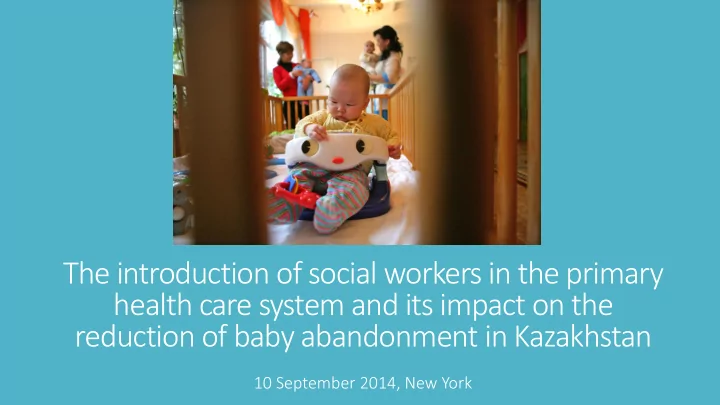

The introduction of social workers in the primary health care system and its impact on the reduction of baby abandonment in Kazakhstan 10 September 2014, New York
Situation in Kazakhstan Until 2010, every year 1.000 children aged 0-3 were entering residential care institutions. The services for the identification of families at risk and preventive strategies were underdeveloped. In 50% of cases parents officially signed “abandonment” papers in maternity wards or shortly after leaving maternity wards.
Main risk factors of women consulting health services risky pregnancy young mothers single mothers mothers with many children teenage girls 9% 9% 26% 26% 42% 42% 7% 7% 16% 16%
Kazakhstan’s commitments after high level conference in Sofia (November 2012) 1. Research the causes of baby abandonment 2. Introduce the management of cases of child abandonment into the job description of social workers 3. Adopt a multi-disciplinary approach for the case management of child abandonment 4. Give more attention to vulnerable families
1. Research findings on the main causes of child abandonment • Poverty, lack of housing • Unemployment • Lack of identification papers • Lack of support from the partner/father or other relatives • Out of wedlock birth of the child • Disability of the child • Teenage pregnancy • Absence of mental health services to address post-partum depression
2. Case management of child abandonment introduced into the job description of social workers • Adoption of the national state programme Salamatty Kazakhstan – Healthy Kazakhstan • Scaled up implementation of the Law On specialized Social Services • Introduction of one social worker per 10.000 inhabitants in maternity wards, family medical centers, youth friendly services and polyclinics (2011) • Adoption of policies and guidelines specifying the role of social workers, including M&E component to monitor progress • Implementation of two comprehensive child abandonment prevention pilot programmes, including the capacity development of social workers and new case management tools (2011-2014) • Improved coverage of social workers
Growing number of social workers 2500 2000 1500 1000 500 0 2012 2013 2014
3. Adoption of multi-disciplinary approach for the case management of child abandonment Registration 80 80-85% Medic ical nurses 1. identification of mothers at risk of child Social abandonment at PHC level and referral Medium and welfare, day hig igh ris isk care Doctors 2. primary needs assessment and initial groups services, case management (pregnant CCTs and Socia ial l Volunteers, women, , benefits work rker community 3. supervision and comprehensive review women wit ith of family needs, individual family support leaders 0-3 aged plan Employment children) ) Partner and housing organisations 4. final cross-sectoral review of plan’s implementation, referrals or closure of the Education case Public and re- announcements training 5. monitoring of high risk family situation after the plan review, referral/case closure Population
4. Give more attention to vulnerable families: future interventions • Re-focus and further develop of preventive services to identify vulnerable families and address risks at early stages • Provide coordinated multi-sectoral response to identify vulnerable families • Measuring the effectiveness of cash benefits to ensure they meet the needs of families • Partnership with the private sector for developing temporary housing solutions
Results achieved
The pilot programme on the prevention of child abandonment led to a reduction of the number of children below three years entering residential care institutions 450 400 350 42% 42% 300 250 200 150 100 50 0 2011 2013
Reduction of children in institutions at national level 16,000 14,000 12,000 10,000 8,000 6,000 4,000 18% 18% 2,000 0 2010 2010 2011 2011 2012 2012 2013 2013 0-18 age 0-3 age
Lessons learned • Strong investment in social work (provision of appropriate budget, capacity development of social workers, development of tools and guidelines) lead to a decrease in the number of children entering institutional care in pilot areas • Awareness raising on parental skills and building confidence among vulnerable families is a key component of government intervention to reduce the number of children in residential care institutions Future plans • Effective pilot initiatives will be scaled up through the adoption of the national regulations by 2015 • Infant homes will be transformed in order to integrate support services for vulnerable families
Remaining challenges How to address the needs of children with disabilities in a more inclusive manner, as they are the first to be abandoned How to ensure the continuum of services for children throughout the lifecycle
Recommend
More recommend